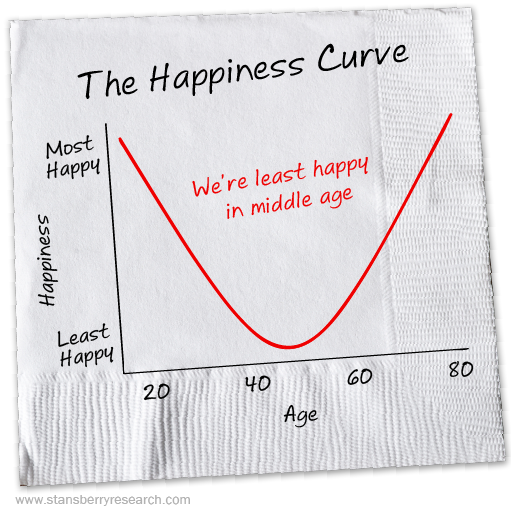You won't believe how many things in life can be explained with a simple curve...
I first learned about this secret in medical school.
Getting just the right balance in many key aspects of life – avoiding too much or too little – will help you lead a better, healthier life.
You can use this simple chart to help figure out how to reap the most benefits on things like how much sleep you should get, alcohol consumption, salt intake, exercise, and sunlight. It can even figure out the secret to happiness...
All of these tend to fall on a U-shaped curve... You want to get right in the middle to reap the most benefits...
Research shows that people's overall happiness falls into a U-shaped curve based on age. That midlife crisis you went through actually has some scientific backing.
But measuring happiness is difficult.
Happiness depends on key factors like physical health, relationships, and job satisfaction.
And your happiness significantly influences your health and wealth.
In 2007, researchers published a paper reviewing data from 2,000 households in the Netherlands. What they saw was that happier people made better investments. They were more willing to save their money instead of spend it on material goods. And when they invested, they were more willing to take healthy risks because they anticipated better outcomes.
Overall, these folks showed that happiness and optimism made them better able to look forward to a positive future. That meant they anticipated better returns and consequently took more risks.
The statistics on why this happens and how to measure happiness get a bit complicated (enough that we could write an entire issue on it). But we know that the reason behind this relationship between happiness and investment ability is that happier people can better adjust to losses because they don't give in to their amygdala...
I've written before about the amygdala... the tiny region of your brain responsible for fear. It's the driving force for your primitive fight-or-flight response. Any kind of threat, including losing money, triggers a rush of emotions, including fear and anxiety.
The area of the brain that keeps the amygdala in line is the prefrontal cortex, or "PFC." The PFC sits right at the top of your brain near your forehead. It's the center of all your planning, decision-making, and behavior control.
As we age and gain experience, our PFC learns to easily overpower the amygdala. This is one of the reasons why older folks are happier than those at middle age on that U-shaped curve.
Similarly, several articles have shown that day traders with positive attitudes see better performance in their portfolios over time. In studies by researchers for the National Bureau of Economic Research, traders with consistently better, more stable moods had overall better portfolio performances. Because their PFCs had more activity, they were able to fight the erratic fears of their amygdalae, meaning big wins or losses did not sway their judgment.
Further studies have shown that practicing ways to actively improve your mood and fight stress directly helps calm the signals in your amygdala.
Here are three things you can do to be happier...
1. Meditate. I love meditation and its powerful effects. Buddhist monks who practice meditation daily have much higher levels of activity in their PFCs. Even people beginning meditation see decreased anxiety. In a 2011 study from the brain research journal Psychiatry Research: Neuroimaging, beginning meditators showed reduced activity levels in their amygdalas when faced with fear-inducing images.
2. Unplug. Penn State University sociologist Glenn Firebaugh researched the resulting depression we have when we see what we have compared with our friends and neighbors, something called the "comparison complex."
Our obsession with the digital age feeds into this negative thinking. Not only are we flooded by television shows and commercials that remind us to buy more to be happier, but social media sites like Facebook let us see at a glance how much better off our neighbors are (or at least appear to be). Falling into the trap of not feeling "good enough" is easy.
So take some time each week to unplug. Try getting outside, for instance, and leave the technology in the house. If you want an easy activity to do, garden.
3. Exercise. Exercise does wonders for happiness. When you work your body, you produce tons of feel-good chemicals, including serotonin. About two and a half hours of exercise per week offers the peak benefit. That's less than 22 minutes of activity a day.
I also enjoy taking walks during the day in the sun. Your body naturally converts sunlight to vitamin D, which helps lift your mood as well.
Taking care of your happiness should be as much of a priority as taking care of your portfolio and your body. Make these tips part of your lifestyle and enjoy the benefits to your health and wealth.
What We're Reading...
- For more insights into happiness and how it affects your investing, check out one of our favorite reads: Your Money and Your Brain by Jason Zweig.
- Something different: AT&T reportedly paid hackers to delete stolen data.
Here's to our health, wealth, and a great retirement,
Dr. David Eifrig and the Health & Wealth Bulletin Research Team
July 18, 2024

